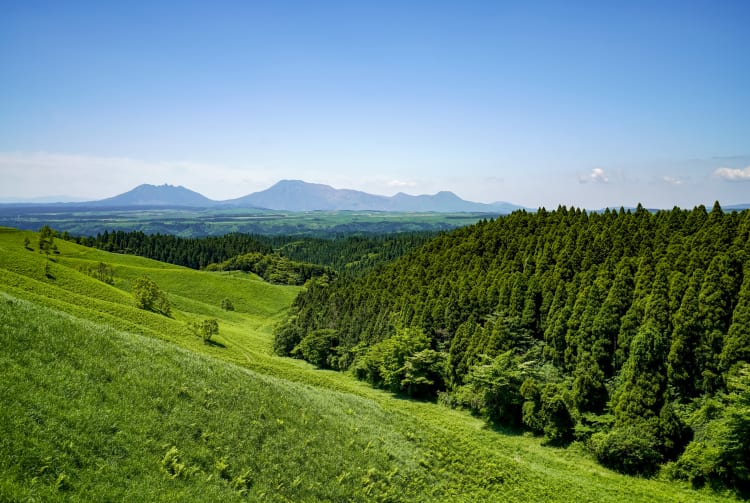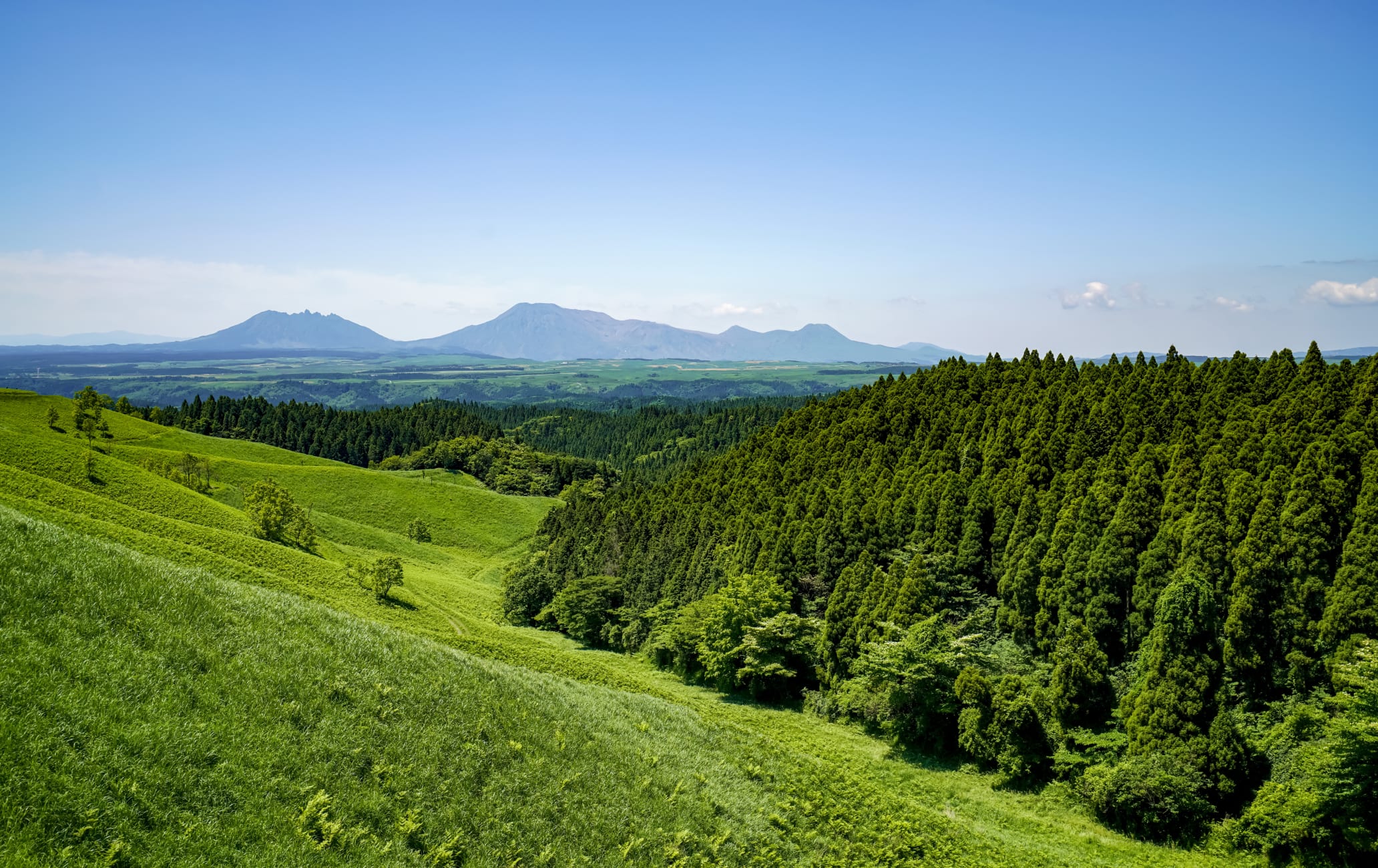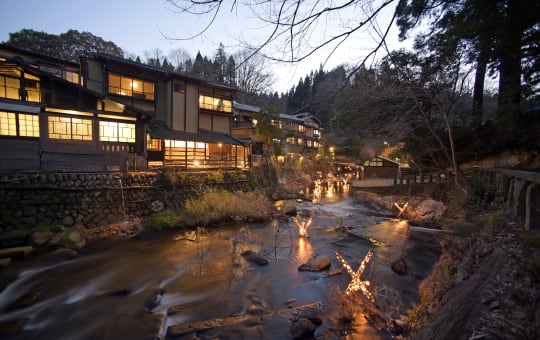National park where hiking and hot spring options abound
The Kurokawa and Kuju areas in Kyushu , Japan's southern island, are some of the most spectacular places to see the natural landscape of Japan. Mountains for scenic hiking and hot springs for unwinding make it a popular area with visitors looking for some outdoor adventure and relaxation.
In the Aso-Kuju National Park , the Kuju mountain range boasts the highest peak on Kyushu, as well as Mt. Aso, the country's largest active volcano. Near these mountains is Kurokawa Onsen, a classic hot spring town.
Don't Miss
- Dipping in a natural "soda pop hot spring" in Kuju
- Strolling in traditional yukata robes in Kurokawa
- Breathtaking views of the surrounding volcanic area after summitting the Kuju range's peaks

How to Get There
Driving is the best way to access the Kurokawa and Kuju areas, but buses are available.
The mountains are about two hours from Kumamoto or 75 minutes from Beppu by car via the Trans Kyushu Route.
Buses are available from those cities to the trailheads for hiking in Kuju, located at either Makinoto Pass or Chojabaru Visitor Center.
Direct buses run from Hakata Station in Fukuoka to Kurokawa Onsen.
Tackling the Kuju mountain trails
Located on the Yamanami Highway, there are two main trailheads for the Kuju mountains. The Chojabaru Visitor Center has information about the area and access to the marshlands; the Makinoto Pass is located closer to the peaks. Choose from various routes but bear in mind a round trip encompassing the main peaks takes up to about six hours to complete.
Taking it easy
If you're looking to enjoy the views via a less physically demanding route, follow the elevated wooden walkways which surround the visitor center going through the Tadawara marshlands. At just 2.5 kilometers, this loop takes about 30-40 minutes to complete and will give you a good taste of what the mountains have to offer. By choosing this route, you can see the Kuju mountains without actually having to climb them.

Activity under the mountains
The Kuju mountain range's five peaks all stand about 1,700 meters tall, but the highest is Mt. Nakadake at 1,791 meters. The views of the surrounding volcanic landscape are breathtaking. The whole area is volcanically active, with nearby Mt. Aso being Japan's most active volcano. Underground steam regularly vents along the slopes, and occasional travel advisories are placed, especially for the main Aso area.
These volcanic characteristics, however, are what give the area the hot springs, impressive landscapes, and rich soil, which in turn gives rise to various flowers. At any time of the year, stop by the Kuju Flower Park located at the southern base of the mountains, to see what's blossoming in the season.
When to visit
If you're hoping to hike the Kuju peaks, bear in mind the time of year can greatly impact accessibility. From December to March, the peaks are usually topped with snow. This makes it difficult, or sometimes impossible, to access the area, as dangerous roads get closed in bad weather.
October and November are traditionally the best times to visit for the spectacular autumn leaves, or in spring when the land is covered in new blooms.
Kuju's mineral-rich hot springs
Regardless of when you visit, a trip to the Kuju mountain range isn't complete without popping by a local hot spring. Whether you need to warm up from cold weather or scrub away the efforts of your six-hour hike, bathing in a natural hot spring will be the perfect finish to your day.
The volcanic activity of the area makes it a prime location for top-quality waters and lends some baths unusual qualities. One such bath is the Lamune Onsen in the Nagayu area to the east and its carbonated "soda pop" water.

Bathing in the black river
While there are many popular onsen in the Kuju area, such as the 1,000-year-old Sujiyu hot spring, the bathing facilities at the Chojabaru roadside station, and those in the Bogatsuru and Senomoto areas, the most popular place for a therapeutic dip is in the nearby onsen town of Kurokawa.
Translating as "black river," Kurokawa is an idyllic town with around 30 different bathhouses to choose from. One of the most well-preserved hot spring towns in Kyushu, Kurokawa is located at an altitude of 700 meters, with the Tanohara river running through the town. Here, the outdoor rotenburo baths are immensely popular, as you can enjoy your dip with views of the forest and sounds of the river.
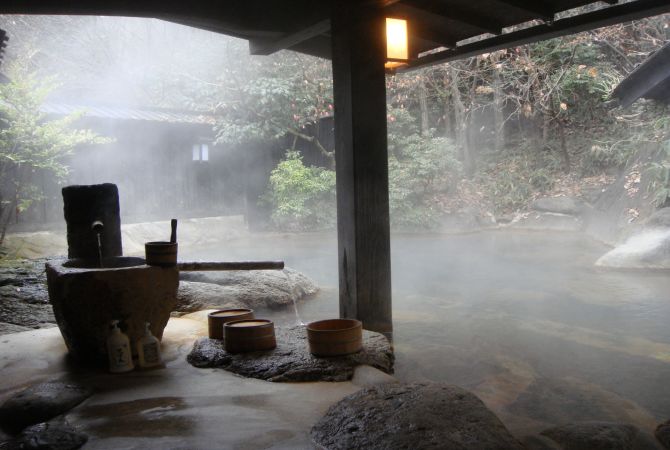

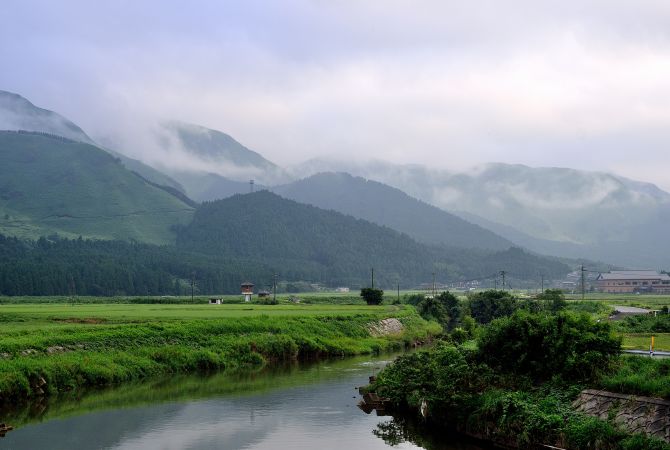

Kurokawa's top hot springs
Some of the top-rated onsen in Kurokawa are Nonohana (hidden in the trees like a fairy tale), Kurokawaso (with a gorgeous mountain location and jade-colored waters), riverside Hozantei, Okyakukya (one of the oldest onsen in Kurokawa), and the award-winning Ikoi Ryokan (featuring 13 different baths). Discover your favorite bath as you leisurely wander the town.
Multiple baths for onsen enthusiasts
For onsen lovers, consider getting an 'Onsen-Hopping Pass' to access three different bathhouses for a reduced price. Valid for six months, the stylish cedar wood pass allows you to enter any three baths among the participating locations as a day visitor. When visiting, feel free to roam the town in your yukata robe and slippers. It's perfectly acceptable, and one of the town's main old-fashioned appeals.
Red or blue?
While traditional hot springs saw male and female visitors using the same area, these days it is common to see gender-separated facilities. A red curtain over the door indicates the entrance for women, whereas the blue curtain is for men. Children up to a certain age are usually permitted to enter either bath, so long as they are accompanied by an adult.
Options for all
Three of the onsens offer barrier-free bathing for wheelchair users while more than half offer private baths for visitors not wanting to bathe naked in front of strangers. This is also a good option for visitors with tattoos, as most onsen facilities do not permit guests to enter the public bath if they have a tattoo, which is traditionally associated with the yakuza, the Japanese mafia.
Staying in Kurokawa
Many of the Kurokawa hot spring facilities also function as traditional ryokan inns, so for an authentic Japanese hot spring experience, consider staying the night (which also gives you double the time to try more baths).
Some rooms include their own personal hot spring facilities as well as access to the public bath. Many ryokan have restaurants for anyone to access, with plenty of local specialties to sample, but the best-staying plans involve breakfast and dinner served in your traditional tatami-mat room.





















































